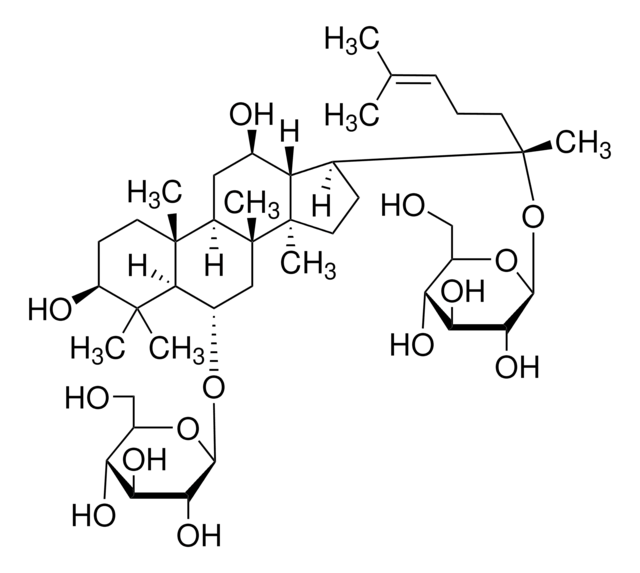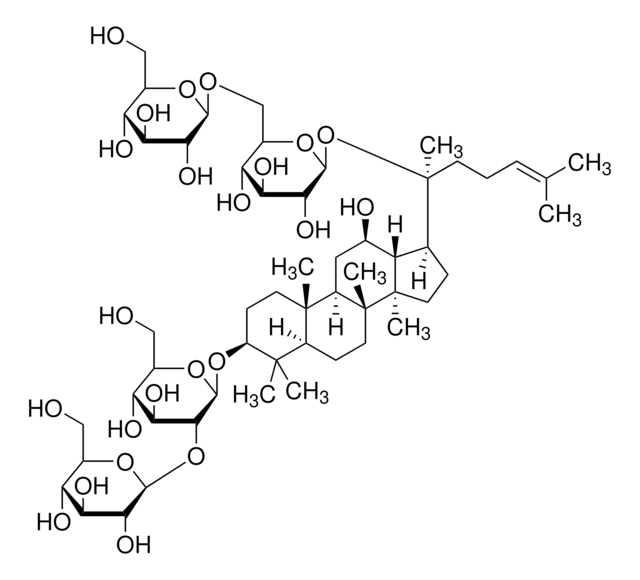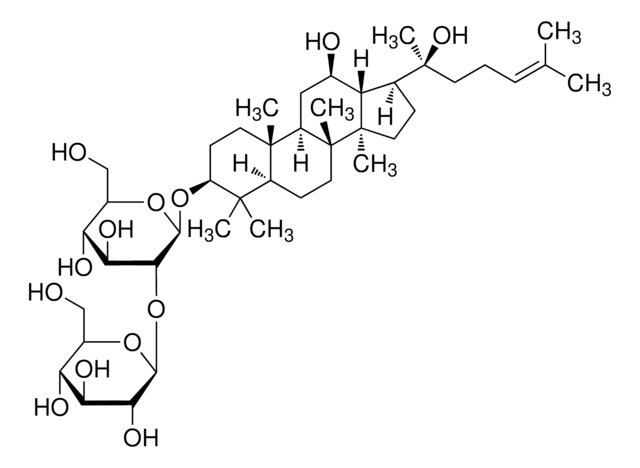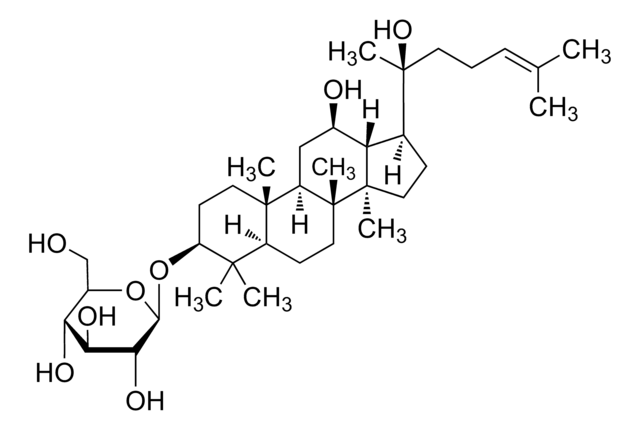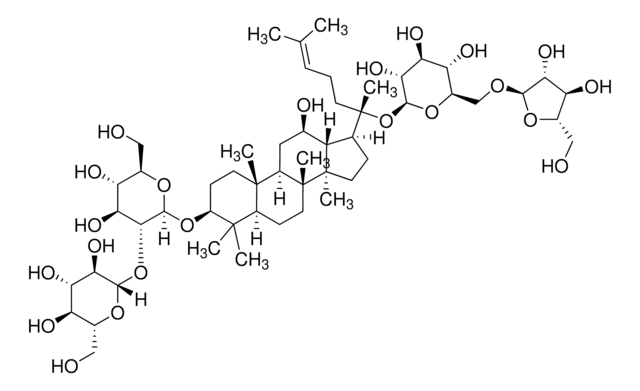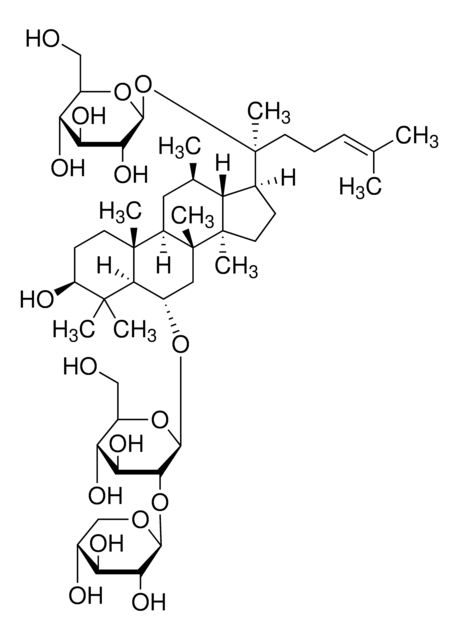00170580
Ginsenoside Rb1
primary reference standard
Synonym(s):
2-O-β-Glucopyranosyl-(3β,12β)-20-[(6-O-β-D-glucopyranosyl-β-D-glucopyranosyl)oxy]-12-hydroxydammar-24-en-3-yl β-D-glucopyranoside, Arasaponin E1, Gynosaponin C, Gypenoside III, Notoginsenoside Rb1, Panaxoside Rb1, Sanchinoside E1, Sanchinoside Rb1
About This Item
Recommended Products
grade
primary reference standard
shelf life
limited shelf life, expiry date on the label
manufacturer/tradename
HWI
technique(s)
HPLC: suitable
gas chromatography (GC): suitable
SMILES string
C\C(C)=C\CC[C@](C)(O[C@@H]1O[C@H](CO[C@@H]2O[C@H](CO)[C@@H](O)[C@H](O)[C@H]2O)[C@@H](O)[C@H](O)[C@H]1O)[C@H]3CC[C@]4(C)[C@@H]3[C@H](O)C[C@@H]5[C@@]6(C)CC[C@H](O[C@@H]7O[C@H](CO)[C@@H](O)[C@H](O)[C@H]7O[C@@H]8O[C@H](CO)[C@@H](O)[C@H](O)[C@H]8O)C(C)(C)[C@@H]6CC[C@@]45C
InChI
1S/C54H92O23/c1-23(2)10-9-14-54(8,77-48-44(69)40(65)37(62)29(74-48)22-70-46-42(67)38(63)34(59)26(19-55)71-46)24-11-16-53(7)33(24)25(58)18-31-51(5)15-13-32(50(3,4)30(51)12-17-52(31,53)6)75-49-45(41(66)36(61)28(21-57)73-49)76-47-43(68)39(64)35(60)27(20-56)72-47/h10,24-49,55-69H,9,11-22H2,1-8H3/t24-,25+,26+,27+,28+,29+,30-,31+,32-,33-,34+,35+,36+,37+,38-,39-,40-,41-,42+,43+,44+,45+,46+,47-,48-,49-,51-,52+,53+,54-/m0/s1
InChI key
GZYPWOGIYAIIPV-JBDTYSNRSA-N
Looking for similar products? Visit Product Comparison Guide
General description
Exact content measured by quantitative NMR can be found on the certificate.
Ginsenoside Rb1 is one of the primary constituents of traditional Chinese medicine, Ginseng. It belongs to the group of triterpene saponins called ginsenosides and pharmacologically, it is one of the most active dammarane-type ginsenosides. It is known to have anti-tumor, anti-oxidant, anti-inflammatory, and cytoprotective properties.
Application
- Development and validation of a liquid chromatography-tandem mass spectrometry (LC-MS/MS) method for the determination of ginsenoside Rb1, naringin, ginsenoside Rb2, and oridonin in rat plasma samples after administrating them weifuchun tablets
- Multi-residue analysis of baicalin, baicalein, wogonoside, wogonin, scutellarin, berberine, coptisine, ginsenoside Rb1, and ginsenoside Re in biological samples of rat plasma by liquid chromatographic-tandem mass spectrometric (LC/MS/MS) method
- Analysis of traditional Chinese herbal decoctions of Dushen Tang and Shenfu Tang for the quantification of 12 ginsenosides by UPLC-MS/MS technique
- Analysis of rhizomes and roots of ginseng for the detection of 131 ginsenosides by UHPLC combined with a diode-array detector and quadrupole/time of flight tandem mass spectrometry (DAD-QTOF-MS/MS), along with the further determination of 19 ginsenosides by HPLC coupled with electrospray ionization-mass spectrometric detection
Other Notes
Signal Word
Warning
Hazard Statements
Precautionary Statements
Hazard Classifications
Acute Tox. 4 Oral
Storage Class Code
11 - Combustible Solids
WGK
WGK 3
Flash Point(F)
Not applicable
Flash Point(C)
Not applicable
Choose from one of the most recent versions:
Certificates of Analysis (COA)
Don't see the Right Version?
If you require a particular version, you can look up a specific certificate by the Lot or Batch number.
Already Own This Product?
Find documentation for the products that you have recently purchased in the Document Library.
Customers Also Viewed
Articles
Ginsenosides Separation in Ginseng. The HPLC method was first optimized using a ginsenoside standard mixture, and was then applied to a sample of American Ginseng root.
Our team of scientists has experience in all areas of research including Life Science, Material Science, Chemical Synthesis, Chromatography, Analytical and many others.
Contact Technical Service